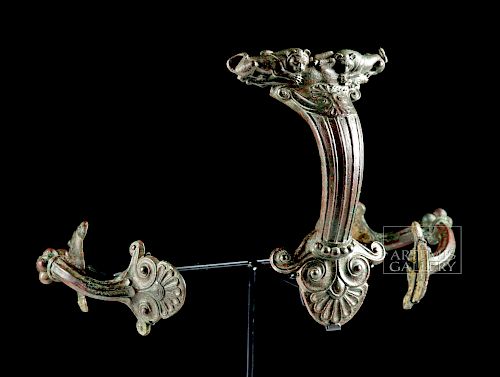Incredible Greek Bronze Hydria Handles - Lionesses
Lot 47c
About Seller
Artemis Fine Arts
686 S Taylor Ave, Ste 106
Louisville, CO 80027
United States
Selling antiquities, ancient and ethnographic art online since 1993, Artemis Gallery specializes in Classical Antiquities (Egyptian, Greek, Roman, Near Eastern), Asian, Pre-Columbian, African / Tribal / Oceanographic art. Our extensive inventory includes pottery, stone, metal, wood, glass and textil...Read more
Estimate:
$12,000 - $18,000
Absentee vs Live bid
Two ways to bid:
- Leave a max absentee bid and the platform will bid on your behalf up to your maximum bid during the live auction.
- Bid live during the auction and your bids will be submitted real-time to the auctioneer.
Bid Increments
| Price | Bid Increment |
|---|---|
| $0 | $25 |
| $300 | $50 |
| $1,000 | $100 |
| $2,000 | $250 |
| $5,000 | $500 |
| $10,000 | $1,000 |
| $20,000 | $2,500 |
| $50,000 | $5,000 |
| $100,000 | $10,000 |
| $200,000 | $20,000 |
About Auction
By Artemis Fine Arts
Feb 21, 2019
Set Reminder
2019-02-21 10:00:00
2019-02-21 10:00:00
America/New_York
Bidsquare
Bidsquare : Exceptional Antiquities, Asian, Ethnographic
https://www.bidsquare.com/auctions/artemis-gallery/exceptional-antiquities-asian-ethnographic-3858
An important one-day auction featuring museum-worthy examples of Egyptian, Greek, Roman, Etruscan, Near Eastern, Far East / Asian, Pre-Columbian, African / Tribal, Oceanic, Native American, Spanish Colonial, Russian, Fossils, Ancient Jewelry, Fine Art, so much more! Artemis Fine Arts info@artemisfinearts.com
An important one-day auction featuring museum-worthy examples of Egyptian, Greek, Roman, Etruscan, Near Eastern, Far East / Asian, Pre-Columbian, African / Tribal, Oceanic, Native American, Spanish Colonial, Russian, Fossils, Ancient Jewelry, Fine Art, so much more! Artemis Fine Arts info@artemisfinearts.com
- Lot Description
Greece, Classical period, ca. mid 5th century BCE. A trio of incredibly-preserved cast bronze handles from a massive hydria, a water vessel with a simple, elegant form and applied handles - two horizontally on each side and a larger one vertically between the two. Each handle is cast with spirals, swirls, and scrollwork, with five of the six terminals identical scroll forms that have an almost anthropomorphic appearance. The sixth terminal - the upper one of the vertical handle - represents a pair of lionesses feeding on the carcass of a deer. The details of the lionesses and deer are lifelike and evocative. The predators are crouched over the corpse, their bodies facing in opposite directions, their heads turned to stare directly at the viewer as if they are caught in the act of feeding, prepared to defend their kill. Size of largest: 5.2" W x 8.05" H (13.2 cm x 20.4 cm); 16.75" H (42.5 cm) on included custom stand.
Hydria frequently appear in scenes of women carrying water from fountains, which was one of women's duties during this time period. The two handles at the sides were used for lifting, while the handle at the back was used to dip and pour. However, bronze examples seem not to have been practical, but rather to have been used solely in a funerary setting. The twin lionesses on this handle represent a theme on ancient Greek vessels of the ferocity and power of these animals. For example, the Vix Krater - the largest krater known, found in a Celtic grave in France, obviously imported from Greece - has three handles, each supported by a rampant lioness. Interestingly, that krater was found in the tomb of a woman - the Lady of Vix - who seems to have been incredibly wealthy and connected via trade to the entirety of Europe and the Mediterranean, including the Baltic, where her amber jewelry came from, and Greece, where her krater came from. Were lionesses a symbol of feminine power? Could these handles have belonged to a hydria made for an elite woman?
Provenance: private East Coast, USA collection; ex-Frances Artuner collection, Belgium, acquired in the 1960s
All items legal to buy/sell under U.S. Statute covering cultural patrimony Code 2600, CHAPTER 14, and are guaranteed to be as described or your money back.
A Certificate of Authenticity will accompany all winning bids.
We ship worldwide and handle all shipping in-house for your convenience.
#142906Rich mottled dark green and brown patina on surface. Incredible preserved details.Condition
- Shipping Info
-
All shipping is handled in-house for your convenience. Your invoice from Artemis Gallery will include shipping calculation instructions. If in doubt, please inquire BEFORE bidding for estimated shipping costs for individual items.
-
- Buyer's Premium



 EUR
EUR CAD
CAD AUD
AUD GBP
GBP MXN
MXN HKD
HKD CNY
CNY MYR
MYR SEK
SEK SGD
SGD CHF
CHF THB
THB

















